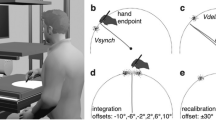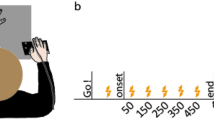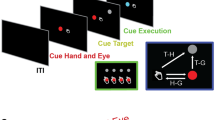Abstract
When planning target-directed reaching movements, human subjects combine visual and proprioceptive feedback to form two estimates of the arm's position: one to plan the reach direction, and another to convert that direction into a motor command. These position estimates are based on the same sensory signals but rely on different combinations of visual and proprioceptive input, suggesting that the brain weights sensory inputs differently depending on the computation being performed. Here we show that the relative weighting of vision and proprioception depends both on the sensory modality of the target and on the information content of the visual feedback, and that these factors affect the two stages of planning independently. The observed diversity of weightings demonstrates the flexibility of sensory integration and suggests a unifying principle by which the brain chooses sensory inputs so as to minimize errors arising from the transformation of sensory signals between coordinate frames.
This is a preview of subscription content, access via your institution
Access options
Subscribe to this journal
Receive 12 print issues and online access
$209.00 per year
only $17.42 per issue
Buy this article
- Purchase on Springer Link
- Instant access to full article PDF
Prices may be subject to local taxes which are calculated during checkout








Similar content being viewed by others
References
Welch, R.B., Widawski, M.H., Harrington, J. & Warren, D.H. Examination of the relationship between visual capture and prism adaptation. Percept. Psychophys. 25, 126–132 (1979).
Ghahramani, Z. Computation and Psychophysics of Sensorimotor Integration. Thesis, Massachusetts Institute of Technology, (1995).
Jacobs, R.A. Optimal integration of texture and motion cues to depth. Vision Res. 39, 3621–3629 (1999).
van Beers, R.J., Sittig, A.C. & van der Gon, J.J.D. Integration of proprioceptive and visual position-information: an experimentally supported model. J. Neurophysiol. 81, 1355–1364 (1999).
Ernst, M.O. & Banks, M.S. Humans integrate visual and haptic information in a statistically optimal fashion. Nature 415, 429–433 (2002).
Sober, S.J. & Sabes, P.N. Multisensory integration during motor planning. J. Neurosci. 23, 6982–6992 (2003).
Soechting, J.F. & Flanders, M. Sensorimotor representations for pointing to targets in 3-dimensional space. J. Neurophysiol. 62, 582–594 (1989).
McIntyre, J., Stratta, F., Droulez, J. & Lacquaniti, F. Analysis of pointing errors reveals properties of data representations and coordinate transformations within the central nervous system. Neural Comput. 12, 2823–2855 (2000).
Flash, T. & Hogan, N. The coordination of arm movements: an experimentally confirmed mathematical model. J. Neurosci. 5, 1688–1703 (1985).
Atkeson, C.G. & Hollerbach, J.M. Kinematic features of unrestrained vertical arm movements. J. Neurosci. 5, 2318–2330 (1985).
Uno, Y., Kawato, M. & Suzuki, R. Formation and control of optimal trajectory in human multijoint arm movement: minimum torque-change model. Biol. Cybern. 61, 89–101 (1989).
Gordon, J., Ghilardi, M.F., Cooper, S.E. & Ghez, C. Accuracy of planar reaching movements. 2. Systematic extent errors resulting from inertial anisotropy. Exp. Brain Res. 99, 112–130 (1994).
Kalil, R.E. & Freedman, S.J. Intermanual transfer of compensation for displaced vision. Percept. Mot. Skills 22, 123–126 (1966).
Wallace, B. & Redding, G.M. Additivity in prism adaptation as manifested in intermanual and interocular transfer. Percept. Psychophys. 25, 133–136 (1979).
DiZio, P. & Lackner, J.R. Motor adaptation to Coriolis force perturbations of reaching movements: endpoint but not trajectory adaptation transfers to the nonexposed arm. J. Neurophysiol. 74, 1787–1792 (1995).
Sainburg, R.L. & Wang, J. Interlimb transfer of visuomotor rotations: independence of direction and final position information. Exp. Brain Res. 145, 437–447 (2002).
Taub, E. & Goldberg, L.A. Prism adaptation: control of intermanual transfer by distribution of practice. Science 180, 755–757 (1973).
Cohen, M.M. Visual feedback, distribution of practice, and intermanual transfer of prism aftereffects. Percept. Mot. Skills 37, 599–609 (1973).
Choe, C.S. & Welch, R.B. Variables affecting intermanual transfer and decay of prism adaptation. J. Exp. Psychol. 102, 1076–1084 (1974).
Kitazawa, S., Kimura, T. & Uka, T. Prism adaptation of reaching movements: specificity for the velocity of reaching. J. Neurosci. 17, 1481–1492 (1997).
Warren, D.H. & Schmitt, T.L. On plasticity of visual-proprioceptive bias effects. J. Exp. Psychol. Hum. Percept. Perform. 4, 302–310 (1978).
Welch, R.B. & Warren, D.H. Immediate perceptual response to intersensory discrepancy. Psychol. Bull. 88, 638–667 (1980).
Andersen, R.A., Snyder, L.H., Bradley, D.C. & Xing, J. Multimodal representation of space in the posterior parietal cortex and its use in planning movements. Annu. Rev. Neurosci. 20, 303–330 (1997).
Wise, S.P., Boussaoud, D., Johnson, P.B. & Caminiti, R. Premotor and parietal cortex: corticocortical connectivity and combinatorial computations. Annu. Rev. Neurosci. 20, 25–42 (1997).
Graziano, M.S.A. Where is my arm? The relative role of vision and proprioception in the neuronal representation of limb position. Proc. Natl. Acad. Sci. USA 96, 10418–10421 (1999).
Graziano, M.S.A., Cooke, D.F. & Taylor, C.S.R. Coding the location of the arm by sight. Science 290, 1782–1786 (2000).
Ghilardi, M.F., Gordon, J. & Ghez, C. Learning a visuomotor transformation in a local area of work space produces directional biases in other areas 73, 2535–2539 (1995).
Rossetti, Y., Desmurget, M. & Prablanc, C. Vectorial coding of movement: vision, proprioception, or both? J. Neurophysiol. 74, 457–463 (1995).
Goodbody, S.J. & Wolpert, D.M. The effect of visuomotor displacements on arm movement paths. Exp. Brain Res. 127, 213–223 (1999).
Sainburg, R.L., Lateiner, J.E., Latash, M.L. & Bagesteiro, L.B. Effects of altering initial position on movement direction and extent. J. Neurophysiol. 89, 401–415 (2003).
Jordan, M. Computational aspects of motor control and motor learning. in Handbook of Perception and Action: Motor Skills (eds. Heuer, H. & Keele, S.) (Academic, New York, 1996).
Good, P. Permutation Tests. Springer Series in Statistics 2nd edn. (Springer-Verlag, New York, 2000).
Efron, B. & Tibshirani, R.J. An Introduction to the Bootstrap (Chapman and Hall, Boca Raton, Florida, 1993).
Acknowledgements
The authors thank M. Kurgansky and L. Osborne for helpful comments on the manuscript and H. Gutierrez for technical assistance. This research was supported by a McKnight Scholar Award, the National Eye Institute (R01 EY15679-01A2), and the Howard Hughes Medical Institute Biomedical Research Support Program grant #5300246 to the UCSF School of Medicine. S.J.S. was supported by a National Science Foundation Fellowship.
Author information
Authors and Affiliations
Corresponding author
Ethics declarations
Competing interests
The authors declare no competing financial interests.
Supplementary information
Rights and permissions
About this article
Cite this article
Sober, S., Sabes, P. Flexible strategies for sensory integration during motor planning. Nat Neurosci 8, 490–497 (2005). https://doi.org/10.1038/nn1427
Received:
Accepted:
Published:
Issue Date:
DOI: https://doi.org/10.1038/nn1427
This article is cited by
-
Integration of proprioception in upper limb prostheses through non-invasive strategies: a review
Journal of NeuroEngineering and Rehabilitation (2023)
-
Retention of visuo-proprioceptive recalibration in estimating hand position
Scientific Reports (2023)
-
Identifying important sensory feedback for learning locomotion skills
Nature Machine Intelligence (2023)
-
Using principles of motor control to analyze performance of human machine interfaces
Scientific Reports (2023)
-
Sensory weighting of position and force feedback during pinching
Experimental Brain Research (2023)



